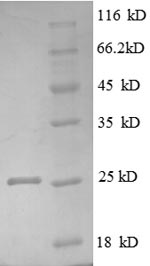Amino acids 31-224 form the expressed segment for recombinant Human LTBR. This LTBR protein is theoretically predicted to have a molecular weight of 25.4 kDa. This LTBR protein is produced using e.coli expression system. The N-terminal 6xHis tag was fused into the coding gene segment of LTBR, making it easier to detect and purify the LTBR recombinant protein in the later stages of expression and purification.
The human tumor necrosis factor receptor superfamily member 3 (LTBR), belonging to the tumor necrosis factor receptor (TNFR) superfamily is a cell surface receptor involved in immune system regulation. LTBR plays a critical role in the activation of the non-canonical NF-κB signaling pathway. LTBR is primarily expressed in B cells, dendritic cells, and certain T cells. Upon binding to its ligand, lymphotoxin alpha/beta (LTα/β), LTBR triggers signaling cascades that modulate immune responses, including the development and organization of lymphoid tissues, such as lymph nodes and spleen. Research on LTBR explores its functions in immune regulation, lymphoid tissue development, and its implications in inflammatory and autoimmune diseases.






